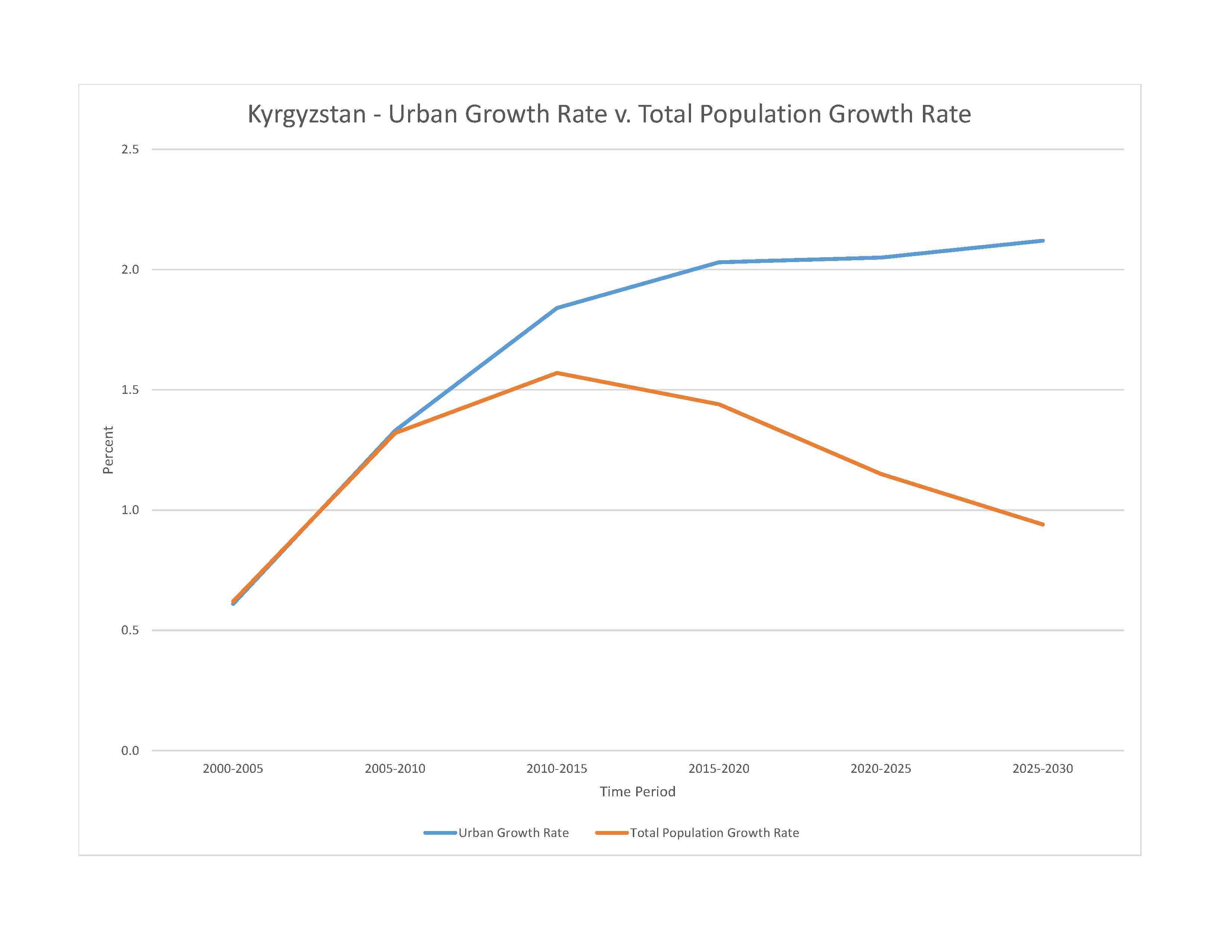
6,122,781 (2023 est.)
noun: Kyrgyzstani(s)
adjective: Kyrgyzstani
Kyrgyz 73.8%, Uzbek 14.8%, Russian 5.1%, Dungan 1.1%, other 5.2% (includes Uyghur, Tajik, Turk, Kazakh, Tatar, Ukrainian, Korean, German) (2021 est.)
Kyrgyz (state language) 71.4%, Uzbek 14.4%, Russian (official language) 9%, other 5.2% (2009 est.)
major-language sample(s):
Дүйнөлүк фактылар китеби, негизги маалыматтын маанилүү булагы. (Kyrgyz)
The World Factbook, the indispensable source for basic information.
Muslim 90% (majority Sunni), Christian 7% (Russian Orthodox 3%), other 3% (includes Jewish, Buddhist, Baha'i) (2017 est.)
Kyrgyzstan is a sparsely populated country whose population is unevenly distributed. More than 50% of the population lives in or around the two cities of Bishkek and Osh and their surrounding districts, which together account for about 12% of the country’s area. Kyrgyzstan’s population continues to grow rapidly owing to its high fertility rate and the traditional preference for larger families, a low mortality rate, a growing share of women of reproductive age, and measures to support families with children. The country has a youthful age structure; over 45% of the population is under the age of 25 as of 2022. Nevertheless, Kyrgyzstan is transitioning from an agricultural society with high fertility and mortality rates to an industrial society with lower fertility and mortality rates.
As part of the USSR, Kyrgyzstan’s rapid population growth was not problematic because its needs were redistributed among the Soviet States. As an independent state, however, population growth became burdensome. International labor migration continues to serve as a safety valve that decreases pressure on the labor market and resources (healthcare, education, and pensions), while also reducing poverty through much-needed remittances. The main destinations for labor migrants are Russia and Kazakhstan, where wages are higher; almost a third of Kyrgyzstan’s working-age population migrates to Russia alone. Outmigration was most pronounced in the 1990s, after the collapse of the USSR, when ethnic Russians, Ukrainians, and Germans left Kyrgyzstan, changing the proportion of ethnic Kyrgyz in the country from barely 50% in 1992 to almost three-quarters today.
While Kyrgyzstan is a net emigration country, it does receive immigrants. The majority of immigrants are from the Commonwealth of Independent States – particularly Kazakhstan, Russia, and Uzbekistan – but more recent arrivals also include persons from China, Turkey, and Turkmenistan. Chinese immigrants work primarily in construction and gold mining, while Turkish immigrants mainly work in construction, trade, education, and services. Border areas between Kyrgyzstan, Tajikistan, and Uzbekistan experience irregular migration, but many of these migrants plan to move on to Europe.
0-14 years: 29.54% (male 928,876/female 879,729)
15-64 years: 63.86% (male 1,914,277/female 1,995,500)
65 years and over: 6.6% (2023 est.) (male 154,684/female 249,715)
total dependency ratio: 63.5
youth dependency ratio: 56.4
elderly dependency ratio: 7.2
potential support ratio: 13.9 (2021 est.)
total: 28.1 years (2023 est.)
male: 26.7 years
female: 29.5 years
0.82% (2023 est.)
19.1 births/1,000 population (2023 est.)
6.1 deaths/1,000 population (2023 est.)
-4.8 migrant(s)/1,000 population (2023 est.)
the vast majority of Kyrgyzstanis live in rural areas; densest population settlement is to the north in and around the capital, Bishkek, followed by Osh in the west; the least densely populated area is the east, southeast in the Tien Shan mountains
urban population: 37.8% of total population (2023)
rate of urbanization: 2.05% annual rate of change (2020-25 est.)

1.105 million BISHKEK (capital) (2023)
at birth: 1.07 male(s)/female
0-14 years: 1.06 male(s)/female
15-64 years: 0.96 male(s)/female
65 years and over: 0.62 male(s)/female
total population: 0.96 male(s)/female (2023 est.)
22.6 years (2019 est.)
50 deaths/100,000 live births (2020 est.)
total: 25.1 deaths/1,000 live births (2023 est.)
male: 29.2 deaths/1,000 live births
female: 20.7 deaths/1,000 live births
total population: 72.6 years (2023 est.)
male: 68.6 years
female: 77 years
2.47 children born/woman (2023 est.)
1.2 (2023 est.)
39.4% (2018)
improved: urban: 100% of population
rural: 89.9% of population
total: 93.6% of population
unimproved: urban: 0% of population
rural: 10.1% of population
total: 6.4% of population (2020 est.)
5.3% of GDP (2020)
2.21 physicians/1,000 population (2014)
4.4 beds/1,000 population (2014)
improved: urban: 100% of population
rural: 100% of population
total: 100% of population
unimproved: urban: 0% of population
rural: 0% of population
total: 0% of population (2020 est.)
16.6% (2016)
total: 4.02 liters of pure alcohol (2019 est.)
beer: 0.43 liters of pure alcohol (2019 est.)
wine: 0.23 liters of pure alcohol (2019 est.)
spirits: 3.35 liters of pure alcohol (2019 est.)
other alcohols: 0 liters of pure alcohol (2019 est.)
total: 25.4% (2020 est.)
male: 48% (2020 est.)
female: 2.8% (2020 est.)
1.8% (2018)
66.2% (2023 est.)
women married by age 15: 0.3%
women married by age 18: 12.9% (2018 est.)
6.2% of GDP (2020 est.)
definition: age 15 and over can read and write
total population: 99.6%
male: 99.7%
female: 99.5% (2018)
total: 14 years
male: 13 years
female: 14 years (2021)
NOTE: The information regarding Kyrgyzstan on this page is re-published from the 2024 World Fact Book of the United States Central Intelligence Agency and other sources. No claims are made regarding the accuracy of Kyrgyzstan 2024 information contained here. All suggestions for corrections of any errors about Kyrgyzstan 2024 should be addressed to the CIA or the source cited on each page.
This page was last modified 04 May 24, Copyright © 2024 ITA all rights reserved.